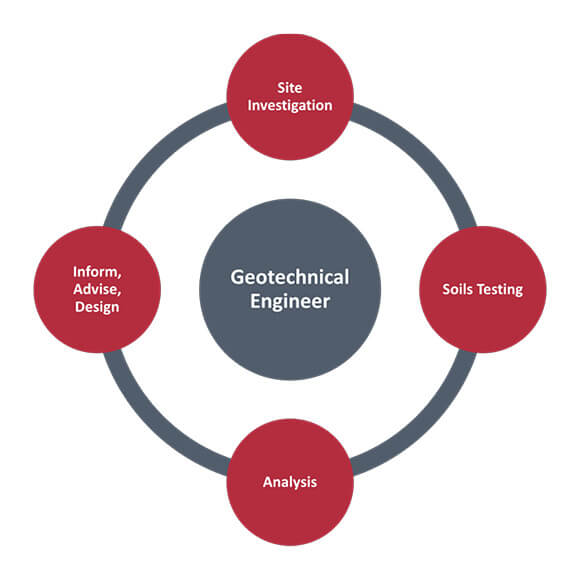5 Easy Facts About Geotheta Explained
5 Easy Facts About Geotheta Explained
Blog Article
The Ultimate Guide To Geotheta
Table of ContentsHow Geotheta can Save You Time, Stress, and Money.9 Easy Facts About Geotheta ShownThe 15-Second Trick For GeothetaThe Greatest Guide To GeothetaThe Best Strategy To Use For Geotheta

They carry out site investigations, accumulate examples, carry out research laboratory examinations, and analyze data to evaluate the suitability of the ground for building tasks - Tailings Engineer. Based upon their findings, geotechnical engineers provide referrals for structure design, slope stability, retaining frameworks, and mitigation of geotechnical hazards. They collaborate with various other specialists, such as engineers, structural designers, and building and construction groups, to guarantee that geotechnical considerations are integrated right into the total project layout and execution
By examining the habits and homes of dirt and rock, they can identify possible geotechnical risks such as landslides, soil settlement, or slope instability. Their experience assists stop failings or accidents that might jeopardize lives and residential property. Below are some thorough responsibilities and obligations of a geotechnical designer: Website Examination: Geotechnical engineers conduct site examinations to gather information on subsurface problems.
They interpret the data to recognize the residential or commercial properties and habits of the soil and rock, including their toughness, leaks in the structure, compaction features, and groundwater conditions. Geotechnical Analysis and Style: Geotechnical engineers assess the data accumulated during site examinations to examine the security and suitability of the site for building tasks. They carry out geotechnical calculations and modeling to examine elements such as bearing ability, negotiation, slope security, lateral planet stress, and groundwater flow.
The Main Principles Of Geotheta
Foundation Design: Geotechnical engineers play a critical role in developing structures that can securely support the desired structure. They evaluate the soil conditions and load requirements to figure out the proper foundation type, such as superficial structures (e.g., footings), deep foundations (e.g (https://issuu.com/geotheta)., piles), or specialized techniques like dirt enhancement. They consider variables such as negotiation limitations, bearing capability, and soil-structure communication to develop optimum foundation styles
They assess building and construction strategies, monitor website tasks, and carry out area inspections to validate that the layout suggestions are followed. If unforeseen geotechnical problems emerge, they assess the scenario and give suggestions for removal or modifications to the design. Danger Evaluation and Reduction: Geotechnical engineers evaluate geotechnical threats and dangers connected with the job website, such as landslides, liquefaction, or dirt erosion.

Cooperation and Interaction: Geotechnical engineers function carefully with other professionals associated with a job, such as designers, architectural engineers, and building and construction teams. Efficient communication and collaboration are important to incorporate geotechnical factors to consider into the general task style and building procedure. Geotechnical engineers give technological know-how, solution queries, and ensure that geotechnical requirements are met.
7 Simple Techniques For Geotheta
Here are some kinds of geotechnical designers: Structure Designer: Structure designers focus on designing and assessing structures for frameworks. They evaluate the dirt conditions, tons requirements, and website characteristics to establish one of the most proper foundation type and design, such as superficial structures, deep foundations, or specialized methods like pile foundations.
They review the elements influencing incline stability, such as soil properties, groundwater conditions, and incline geometry, and create approaches to avoid slope failings and reduce risks. Quake Designer: Quake engineers concentrate on examining and making structures to endure seismic pressures. They analyze the seismic threat of a site, review soil liquefaction potential, and establish seismic layout criteria to ensure the safety and security and strength of structures throughout quakes.
They perform field screening, gather examples, and assess the collected information to characterize the dirt properties, geologic formations, and groundwater problems at a site. Geotechnical Instrumentation Designer: Geotechnical instrumentation designers focus on surveillance and gauging the actions of dirt, rock, and frameworks. They install and preserve instrumentation systems that keep track of aspects such as dirt settlement, groundwater degrees, incline activities, and architectural variations to examine efficiency and provide early warnings of prospective concerns.
The Definitive Guide to Geotheta
They perform examinations such as triaxial tests, consolidation examinations, direct shear examinations, and permeability examinations to gather data for geotechnical evaluation and design. Geosynthetics Engineer: Geosynthetics engineers concentrate on the design and application of geosynthetic products, such as geotextiles, geogrids, and geomembranes. They make use of these products to boost dirt security, reinforce slopes, supply drain services, and control disintegration.
They often tend to be investigatory individuals, which implies they're intellectual, introspective, and investigative. They are curious, systematic, reasonable, logical, and logical. Several of them are also social, meaning they're kind, charitable, participating, patient, caring, valuable, compassionate, skillful, and pleasant. Does this sound like you? Take our free career examination to find out if geotechnical designer is among your top occupation matches.
In the office setting, geotechnical engineers utilize specialized software application devices to execute estimations, produce designs, and examine data. They prepare reports, evaluation job requirements, connect with customers and employee, and coordinate task tasks. The office setting gives a favorable atmosphere for research, analysis, and collaboration with other specialists associated with the job.
The Buzz on Geotheta
They frequently go to task sites to conduct site investigations, analyze geotechnical problems, and gather data for evaluation. These gos to entail taking a trip to various areas, sometimes in remote or challenging surfaces. Geotechnical engineers might carry out soil sampling, conduct examinations, and display building tasks to ensure that the geotechnical aspects of the project are being applied appropriately.
Geotechnical designers additionally function in specialized geotechnical labs. Geotechnical research laboratory designers function thoroughly in these atmospheres, handling testing equipment, running instruments, and tape-recording data.
Report this page